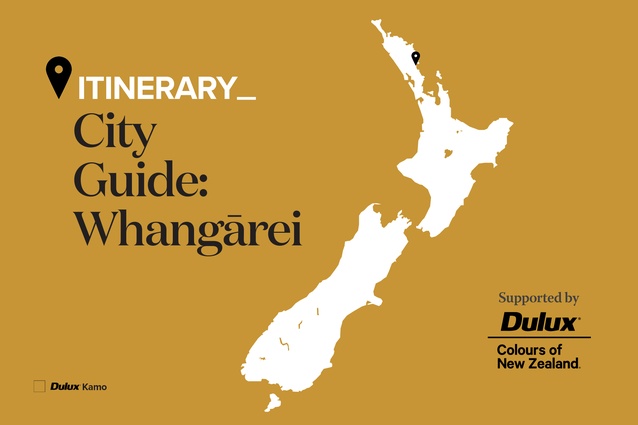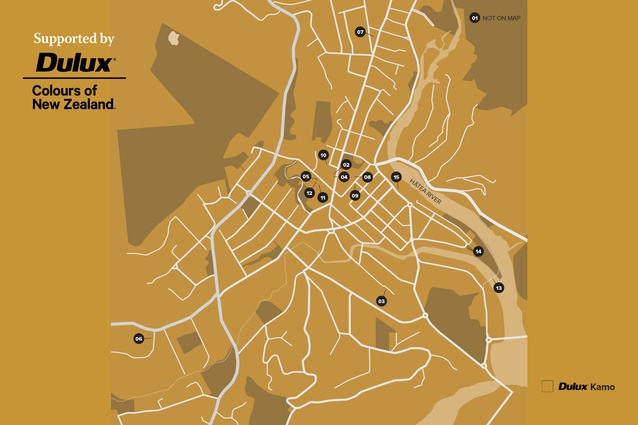Itinerary City Guide: Whangārei
In this Itinerary, supported by Dulux Colours of New Zealand, Andrew Barrie profiles fifteen notable buildings in the northern city of Whangārei, including a collection of interesting public buildings in a region that's limited resources have fostered alternative design models and adventurous locals.
Whangārei Harbour has been significant since our earliest days, serving as a landing point for migratory waka and a centre for trade during pre-colonial times. As the missionaries and settlers moved south from the Bay of Islands, several families took up residence from the 1830s but fled in 1845 when conflict broke out in the north; many did not return. The town later developed as a port for natural resources extracted from the hinterland – particularly after coal was found nearby – the port located in what is now the Town Basin.
The economic importance of coastal shipping routes faded when rail linked the city to the nation in the 1920s. Construction of the Marsden Point Oil Refinery boosted the region in the 1960s and Northport in the 2000s, though Northland’s economy lost vigour relative to other regions. The city has retained, though, an interesting collection of buildings. Perhaps an upside of its relatively low density has been a pattern of letting old buildings take on new uses. Where other cities have scrapped and replaced amenities, Whangārei’s old post office, council offices and libraries survive.
As the listings show, while much has been built by out-of- towners, the city has a lineage of adventurous and accomplished locals. These now include established firms such as HB Architecture, as well as practices adopting alternative models – community-based facilitators ĀKAU and kaupapa Māori specialists Matakohe Architecture + Urbanism.
Whangārei boasts a couple of our most interesting recent public buildings. The Hundertwasser Art Centre celebrates Friedenreich Hundertwasser’s art and his exuberant approach to making buildings. It repudiates the cool sophistication of most contemporary architecture. Where so much of what we do is fragile – the way a building is occupied can diminish or overwhelm design intentions – this building is muscular. It is, though, not without contradictions – while not exactly bling-ed out, it is wildly bespoke; its $33m budget was very generous and its apparent looseness has had to be carefully contrived. The Hihiaua Cultural Centre is a community space for waka restoration and other Māori crafts. An unassuming structure employing humble materials, its key moves are simple – notably, a spacious porch animated by sliding screens and doors. In the face of much community life and volunteerism being privatised and professionalised, it is an exemplar of a community with limited resources benefiting from an architect’s skill. Again, the story is not straightforward – the Centre is intended as the first stage of a sprawling $20m scheme.
So, while Whangārei connects deeply into our history, it also presents – whether alternatives to our habitual modes or the simple re-use of old buildings – some key paths forward.
THE ITINERARY
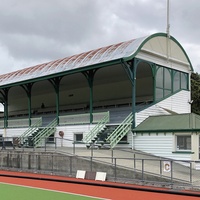
01. 1903 – Kensington Park Grandstand
45 Park Avenue, Kensington
Edward Bartley
One of the most prolific architects of his time, Bartley is best known for the Princes Street Synagogue and the Blind Institute building, both in Auckland. He was very active in Whangārei, designing churches and commercial buildings, the Municipal Chambers, and several buildings at the hospital, little of which survives. This grandstand, built in Kensington Park to serve the Agricultural and Pastoral Society and the local racing club, is one of the few in New Zealand with a barrel roof. It has been relocated and now serves the main hockey pitch at Northland Hockey Association on the northern edge of Kensington Park.
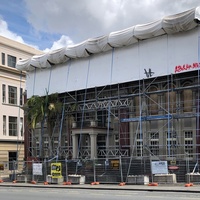
02. 1912 – Whangārei Municipal Chambers
71 Bank Street
Hugh Grierson
Edward Bartley had built municipal chambers just after the turn of the century. The current building was designed by Hugh Grierson who would later go into practice with Kenneth Aimer and Keith Draffin and produce the Auckland War Memorial Museum. Demonstrating how small and intertwined the profession was at that time, Draffin had trained in Bartley’s office. Standing in a line-up of civic and financial institutions, the Municipal Chambers originally included a public reading room and library on the ground floor, with borough and county offices above. The building was severely damaged by fire in 2019 – it is still scaffolded and repairs are due to start this year.
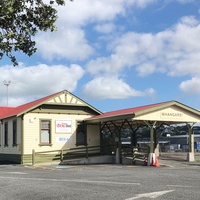
03. 1925 – Whangārei Railway Station
Railway Road
NZ Railways Architectural Department
under Sir George Troup
A harbour city, Whangārei was formed around shipping. The station arrived relatively late: part of the burst of railroad building in the first part of the 20th century. Its completion marked the linking of Northland into the national network. The design is a variation on the pattern typical of regional stations – a timber station building with steel-framed platform roof – but it was one of the last produced under the direction of Troup, who retired from the railway in 1925 and was later elected mayor of Wellington. The Northland line no longer serves passengers and the station is now home to local social clubs.
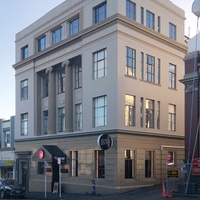
04. 1926 – Former Public Trust Office
69 Bank Street
Stanley W. Fearn
British-born, Wellington-based Fearn was the winner (with Austin Quick) of the NZIA’s first-ever Gold Medal in 1927 – in the days when the judging was carried out by the RIBA in Britain – for the William Booth Memorial Training College in Wellington. Fearn designed Public Trust Offices in several provincial centres, including Hawera, Hastings and Tauranga, here producing a nearly symmetrical composition in a Stripped Classical style. The Public Trust has now moved on but the building is still in relatively original condition – a visit to the bar on the ground floor gives a taste of the grand public spaces.
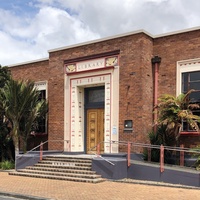
05. 1936 – Whangārei Central Library
7 Rust Avenue
Horace Massey and Alfred Morgan
Massey was one of New Zealand’s most influential architects between the wars, winning four NZIA Gold Medals between 1933 and 1940. Massey and Morgan had practised together in Auckland in the 1920s, and continued to collaborate when Morgan was later based in Whangarei. This building, a crisp but fairly unassuming neo- Georgian composition in brick and pale stone, earned them both an NZIA Gold Medal. The building was extended in 1964 by local architect Charles Corne and, again, in the 1980s by Peter McNaught, another local. It was later replaced by a new building at its rear. See Home & Building, Feb 1939.
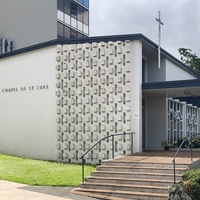
06. 1962 – Chapel of St Luke, Whangārei Base Hospital
Hospital Road, Maunu
Haughey, Fox and Partners
Again, Edward Bartley had designed (pro bono) Whangārei’s first proper hospital in 1901. In the 1950s, with the local population growing, Haughey, Fox and Partners commenced work on a modern ‘base hospital’, with this crisp chapel tucked in against the base of a ward tower. It has an entry from the street but a direct connection to the wards. Kerry Francis says, “The building pursues later modernism’s fascination with the play of light on often heavily textured surfaces. It is constructed primarily with stretcher bond brick, which is plastered externally, and exposed internally, between plastered concrete frames, ensuring a gentle warm atmosphere.”
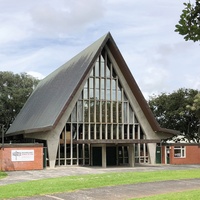
07. 1963 – Christ Church
2 Kamo Road, Regent
Kingston, Reynolds, Thom, and Allardice
The Anglicans have had a presence in Whangārei since the time of the early settlers, who held regular services in their homes. The first church built on this site was dedicated by Bishop George Selwyn in 1860. The current building was produced by modernist maestro Ian Reynolds at KRTA, at the time New Zealand’s only multidisciplinary consulting firm. Its architectural output was largely commercial and university work but the practice also designed a fairly eclectic series of churches, with this perhaps the most refined. The heft of its reinforced concrete columns is offset by elegantly tapered geometry and delicate timber in-fills.
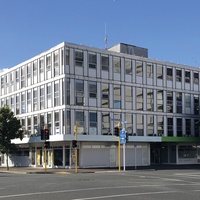
08. 1964 – Fletcher House
25 Rathbone Street
Franz Iseke
Iseke is one of our lesser-known émigré architects. German but born in the Far East, he studied at Harvard and met his Kiwi wife in Australia before arriving in New Zealand in 1950. He worked at innovative commercial firm Thorpe, Cutter, Pickmere and Douglas before starting his own practice. His published work is stripped-back, Case Study-style houses but he produced commercial buildings of various sizes. Occupying a whole city block and overlooking a park, this project evokes Basel more than it does provincial Aotearoa. Built for the Fletcher Trust and Investment Company, its ground floor is shops with three floors of leasehold offices above.
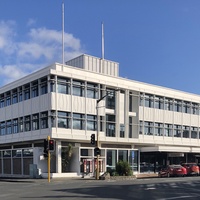
09. 1967 – Former Post Office
16 Rathbone Street
Government Architect’s Street
Sheppard served as Government Architect during a time of huge growth (1959–1971) and several regional post offices were designed during his tenure, including the frilly, circular landmark in Putāruru (1970) and a svelte international-style structure on pilotis in Hawera (1967). The Whangārei structure, designed by Regional Architect J. H. Barker for the Government Architect’s Office, is less demonstrative – a four-square but elegant composition in pre-cast concrete, lightened by bands of windows and delicate sunshades. With the evolution of postal services, all these buildings have changed use, and this project was recently refitted as the regional Māori Land Court.
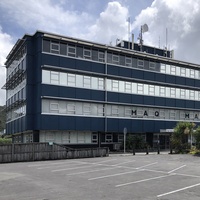
10. 1971 – State Advances Corporation (SAC) Building
3-5 Hunt Street
Beatson, Rix-Trott, Carter and Co
The Beatson et al. partnership, which originally included Horace Massey (see listing 5), produced in the postwar period innovative buildings across a huge range of types – commercial, industrial, university, churches, fine houses and so on. Following Massey’s lead, the firm was active in Whangārei, including preparing a proposal for a civic centre in 1966. In the period before banks offered mortgages, State Advances was a key source of home loans to low and moderate-income earners. Policy changes rapidly increased loan volumes in the 1960s but the SAC was disestablished in the mid-1970s, not long after this building was completed.
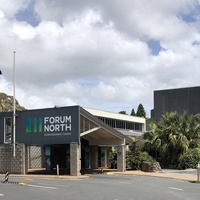
11. 1982– Forum North
7 Rust Avenue
Smith, Grant, and Associates
The Whangārei Civic, Cultural, Conference & Arts Centre contains “City Council offices and Council Chambers, exhibition hall, spaces for the arts and crafts, theatre, restaurant and bar, information centre and administration offices for the centre”. Organised around an internal street, the interior is a symphony in the humbler elements of early-1980s’ design – concrete block, timber linings, stained glass, exposed timber trusses and roof lights. The council offices will soon move to the new Civic Centre nearby, and there is a scheme by Shand Shelton to insert a sizable new theatre into the footprint of the old offices. See Home & Building 4, 1982.
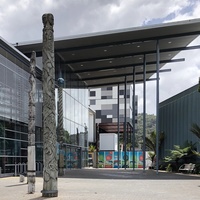
12. 2005– Whangārei Central Library
5 Rust Avenue
Jasmax
One of a series of libraries Jasmax produced in the mid-2000s, this is the most urbane: placed between a cultural precinct and a park. Visitors pass behind the old library to discover a huge entrance canopy. This canopy roof extends back into the building to define an open, top-lit, two-storey collections zone. Ancillary facilities, such as special collections, meeting rooms, a children’s area and a café, are tucked into more enclosed spaces down each side. This simple organisation creates a sense of scale and clarity where contemporary libraries have tended towards a domestic sensibility. See Architecture NZ Sept/Oct 2006.
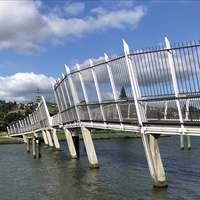
13. 2014– Kotuitui Whitinga Footbridge
Town Basin
HB Architecture
Local firm Harris Butt Architecture is best known for its series of cultural facilities at Waitangi, and for the dramatic Knoll Ridge Café (2012) on Whakapapa Ski Field. This opening bridge, located behind the Hihiaua Culture Centre, spans the Waiarohia Stream to create a riverfront walkway that loops from the Town Basin Marina and back along the Hatea River. Harris Butt fans should also look up its Quarry Café (2018), at 21 Selwyn Avenue, and Te Kakano (The Seed), a Hundertwasser-ish folly, Quayside, built in 2016 to test the design and construction methods for the Art Centre later built next to it.
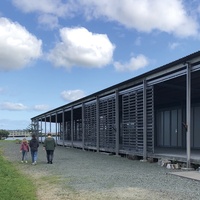
14. 2019– Hihiaua Cultural Centre
56 Herekino Street
Moller Architects
Awarding this building, the first in a multi-stage development, the NZIA John Scott Award for Public Architecture in 2020, the jury stated, “Embracing the adjoining industrial estate vernacular, this whare as warehouse incorporates a Whare Toi, for Māori arts and craft, and a Whare Waka, for canoe restoration. … As with a traditional whare, the Hihiaua Cultural Centre has what one can read as a mahau, or porch. Yet this porch is massive: four metres wide and 60 metres long, extending along the full face of the building for accommodating outdoor social”activities.” See Architecture NZ“May/Jun 2021.
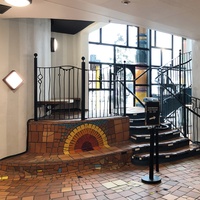
15. 2021– Hundertwasser Art Centre
81 Dent Street
Friedensreich Hundertwasser
The design is attributed to Hundertwasser in collaboration with HB Architecture, Springmann Architektur and The Hundertwasser Non Profit Foundation. Bill McKay has stated the building, which includes New Zealand’s only gallery dedicated to Māori art, prompts “some fundamental questions about architecture: what it is, who or what it is for and how we do it”. It seems intended to leave tradies empowered, children delighted and architects wondering if they’ve been wrong all their careers. Architects should visit with a civilian, keeping in mind the difficulties that inevitably ensue when architects’ tastes diverge widely from those of the public. See Architecture NZ Mar/Apr 2022.
Other addresses
J. W. Court Store (1943) 41 Walton Street Alfred Morgan A slice of streamlined modernism sweeps around a key corner site. See Home & Building, Jun 1943.
Carr Brothers Motors (1966) Corner Rathbone and Dent Streets Herb Shattky This car dealership is now swamped by signage but the stylish bones are still discernible. See Home & Building, Oct 1967.
McKay Electrical Building (1967) 38 Water Street E. T. Smith, Sinclair & Assocs See Home & Building, Aug 1968.
Te Matau a Pohe Lower Hatea Bridge (2013) Dave Culham Drive Knight Architects
SOURCES
Several general histories of Whangārei touch on architecture, the most useful of which are Florence Keene’s Between Two Mountains: A History of Whangarei (Auckland: Whitcombe & Tombs, 1966) and Nancy Pickmere’s Whangarei: The Founding Years (Whangarei: N. Pickmere, 1986). Have a look, also, at Jenny Bartlett’s Cobwebs and Gables: A Study of Historic Buildings, Places and Objects in Whangarei (Whangarei: Whangarei City Planning Dept, 1982). For specific buildings, see M. W. Bartley’s Colonial Architect: The Career of Edward Bartley 1839–1919 (Wellington: First Edition Publishers, 2006) and Stephen Stratford (ed.), Jasmax (Auckland: New Zealand Architectural Publications Trust, 2007). The academic Kerry Francis has written several scholarly papers on aspects of Whangārei architecture as well as the Whangārei entries in Julia Gatley’s Long Live the Modern (Auckland: Auckland University Press, 2008).

The itinerary series is supported by Dulux Colours of New Zealand. Dulux Colour Specialist Davina Harper has selected a Colours of New Zealand palette based on this itinerary. See the full range and order colour samples here.

